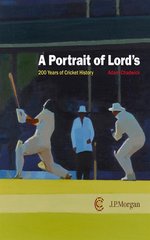A Portrait of Lord’s
Martin Chandler |Published: 2013
Pages: 288
Author: Chadwick, Adam
Publisher: Scala Publishing
Rating: 4 stars

There is undoubtedly something special about Lord’s. I have never been quite so awe-struck by anything as I was by simply being at the spiritual home of the game on the first occasion I entered its hallowed portals, and the feeling has been much the same on each succeeding visit. On one cold November day a couple of years ago I had cause to go to an empty Lord’s, shorn of any matchday atmosphere, and all but deserted, but the effect on me was much the same.
In light of that continuing experience it has never surprised me at all that so many books have been written about the ground. Plum Warner, Ian Peebles, John Marshall, Geoffrey Moorehouse and Stephen Green are just five names that I can reel off who have written a book about Lord’s, and there are plenty of others who have authored work that touches and concerns aspects of the ground, its history and its collections.
It has been ten years since Green’s book appeared, so I suppose that there is another generation looking around the world’s bookstalls, but it did still seem to me, on hearing that A Portrait of Lord’s was about to be published, that it might prove to be a volume too far in terms of making any significant addition to the literature of the game.
The weighty tome that appeared on my doorstep has a hefty price tag, GBP35, but then it does bear the imprint of the MCC itself, and has the patronage of JP Morgan. It is of course also bang up to date, but most encouagingly has the look and feel of a book that lives up to the emotions that its subject matter inspires.
As indicated I have yet to walk into Lord’s without the hairs on the back of my neck standing up, a lump forming in my throat and my eyes misting over. None of the books that I have read about Lord’s in the past have even begun to replicate that, and of course they never could, but in fairness to A Portrait of Lord’s, it certainly quickens the pulse.
The key to the book is the number of, and quality of its illustrations. It is not a learned treatise on the ground. There is a well-written and concise narrative, but that is just the glue that holds together some superb imagery of the ground and more particularly its art, antiquities and memorabilia.
There are more paintings than anything else, some well known, some not so, but the reproduction is of a very high quality indeed. The most interesting to me was a rather odd portrait of Michael Vaughan which, I have to confess, when I first saw it I adjudged to be totally devoid of merit, whether artistic or otherwise. Since then I have seen rather more of Vaughan due to his media work and as a result got to know his personality better – and I have also now had the opportunity to read what is said here about what the artist set out to achieve. Needless to say I am satisfied now that my initial reaction was flawed and ill-conceived.
For book collectors there are some interesting images. Most evocative is a full-sized photograph of EW Swanton’s 1939 Wisden, the copy that was incarcerated with him in a Prisoner of War camp in Burma. Duly stamped as “non-subversive” by his Japanese captors, the book was lovingly repaired on numerous occasions with whatever materials were available, and is distinctly battered in appearance. Whilst it is impossible for anyone born since that particular conflict ended to begin to imagine how the inhumane conditions in those camps must affect a man, it is certainly possible to have some idea of how thumbing through that Wisden must have, albeit briefly, conjured up reassuring mental images of Don Bradman approaching Len Hutton to congratulate him as the Yorkshireman moved past the record individual Test score at the Oval in 1938.
Whilst on the subject of books there is also a photograph of a set of Britcher’s Scores, an annual publication that appeared in 15 editions beginning in 1790. Only about fifty copies survive in total, and only Lord’s has a full set. What do these priceless artifacts look like? A handful of tatty old volumes on the face of matters fit only for pulping is the honest answer – makes a man think that perhaps there is a point to setting up a house clearance business after all!
I could go on, but for anyone who is interested in what I am talking about there really is no substitute for owning a copy of this sumptuous production, so if Lord’s and cricketana float your boat, and you have a few bank notes spare, this is a book that is well worth investing in.






Leave a comment